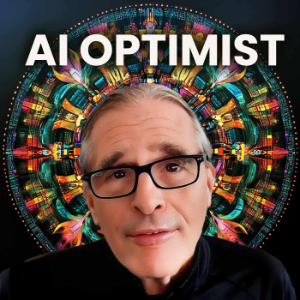
The AI Optimist
Business & Economics Podcasts
The AI Optimist cuts through the usual AI noise connecting creators and tech to work together instead of fighting. I'm a Creative AI Strategist who helps creators and businesses co-create with AI, turning humble machines into powerful creative partners. As a subscriber, you will immediately receive The Creator's AI Licensing INTEL. .
www.theaioptimist.com
Location:
United States
Description:
The AI Optimist cuts through the usual AI noise connecting creators and tech to work together instead of fighting. I'm a Creative AI Strategist who helps creators and businesses co-create with AI, turning humble machines into powerful creative partners. As a subscriber, you will immediately receive The Creator's AI Licensing INTEL. . www.theaioptimist.com
Language:
English
Contact:
5302356331
Website:
https://www.theaioptimist.com/
Email:
declan@dunnsimply.com
Creative Machines and Human Creativity: Building AI that Makes Us More Creative Instead of Replacing Us
Duración:00:23:24
Breaking the $4/Min Barrier: How AI Pays $120 for Raw Video and $30 for another?
Duración:00:16:34
AI Pays Authors $3,000 Per Book?! 2025 Licensing Rates for Writers & Photographers
Duración:00:19:48
The Beginning is Near - The AI Bubble Finally Burst and that's the Best Thing!
Duración:00:19:12
Humble Creative Machines: Creating AI to Elevate You (Instead of Replacing You)
Duración:00:21:06
Zero Sum AI Game? Everyone Loses When Artists vs Engineers Make AI Dumber
Duración:00:10:06
Fear and Loathing in the Cult of AI: 3 Steps to Waking from the Subtle Matrix
Duración:00:16:08
Trump Kills AI Copyright Rules: How Creators Thrive NOT Survive Now
Duración:00:15:03
Free AI Content is Over: License or Die
Duración:00:20:34
The AI Emperor Has No Code: When $1.5B Startups Fake AI and Governments Silence Creators
Duración:00:12:15
The TikTok AI Blueprint: UK and US Adopt SV's 'Take First, Get Lawyers, Pay Later'?
Duración:00:23:30
This AI Paints, Invents, Dreams - Growing from a Near-Death Experience
Duración:00:16:15
The Most Pro-AI Company You've Never Heard Of Is Fighting For Creator Licensing (And Why Big Tech Worries)
Duración:00:15:02
A 48-Hour AI Copyright Heist: The USCO Bombshell Report & The Perlmutter Purge
Duración:00:14:57
The $5M AI Video Licensing Wave: Why AI Companies Pay $1-4 Per Minute For Video
Duración:00:11:22
AI-Proof Your Game: The Creative Currency AI Can't Counterfeit
Duración:00:20:40
Thinking Outside the Human Box: How Copyright Creates the AI Liar's Dividend
Duración:00:21:04
Your Brain Beats AI: How to Make ChatGPT Stop Speaking in Tongues
Duración:00:19:50
The AI Belief Codes: True Believers versus the rest of us
Duración:00:25:55
🌊Creative AI Jobs Rising? How I Learned to Stop Worrying and Love AI
Duración:00:18:54